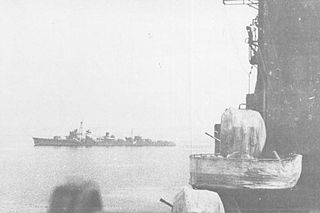
Chikuma (筑摩) was the second and last vessel in the Tone class of heavy cruisers in the Imperial Japanese Navy. The ship was named after the Chikuma River, in Nagano prefecture of Japan. Entering service in 1939, Chikuma saw battle during World War II in the Pacific. She was scuttled on 25 October 1944 after the Battle off Samar.
Tone (利根) was the lead ship in the two-vessel Tone class of heavy cruisers in the Imperial Japanese Navy. The ship was named after the Tone River, in the Kantō region of Japan and was completed on 20 November 1938 at Mitsubishi's Nagasaki shipyards. Tone was designed for long-range scouting missions and had a large seaplane capacity. She was extensively employed during World War II usually providing scouting services to their aircraft carrier task forces. She almost always operated in this capacity in conjunction with her sister ship Chikuma.

The Mogami class (最上型) were four cruisers built for the Imperial Japanese Navy (IJN) during the 1930s. They were initially classified as light cruisers under the weight and armament restrictions of the London Naval Treaty. After Japan refused to comply any longer with that agreement, all four ships were rearmed with larger guns and were reclassified as heavy cruisers. All four sisters participated in World War II and were sunk.

Yokosuka Naval Arsenal was one of four principal naval shipyards owned and operated by the Imperial Japanese Navy, and was located at Yokosuka, Kanagawa prefecture on Tokyo Bay, south of Yokohama.

Kumano (熊野) was one of four Mogami class of heavy cruisers in the Imperial Japanese Navy, serving in World War II. She was named after the Kumano River Kii Peninsula on the island of Honshu in central Japan. The Mogami-class ships were constructed as "light cruisers" with five triple 6.1-inch dual purpose guns. They were exceptionally large for light cruisers, and the barbettes for the main battery were designed for quick refitting with twin 8-inch guns. In 1937 all four ships were "converted" to heavy cruisers in this fashion. Kumano served in numerous combat engagements in the Pacific War, until she was eventually sunk by carrier aircraft from Task Force 38 while she was undergoing repairs at Santa Cruz, Zambales, Philippines, in November 1944.

Mikuma was the second vessel in the four-vessel Mogami class of heavy cruisers in the Imperial Japanese Navy. She was named after the Mikuma river in Oita prefecture, Japan. Commissioned in 1935, she participated in the Battle of Sunda Strait in February 1942 and the Battle of Midway in June 1942. She was sunk the last day of the battle, June 6.
Suzuya (鈴谷) was the third of four vessels in the Mogami class of heavy cruisers in the Imperial Japanese Navy. She was named after the Suzuya River on Karafuto, (Sakhalin).

Hayashio was the fifth vessel to be commissioned in the 19-vessel Kagerō-class destroyers built for the Imperial Japanese Navy in the late-1930s under the Circle Three Supplementary Naval Expansion Program.

Oyashio was the fourth vessel to be commissioned in the 19-vessel Kagerō-class destroyers built for the Imperial Japanese Navy in the late-1930s under the Circle Three Supplementary Naval Expansion Program.

Novík was a protected cruiser in the Imperial Russian Navy, built by Schichau shipyards in Elbing near Danzig, Germany.

The Furutaka-class cruisers were a class of two heavy cruisers which saw service with the Imperial Japanese Navy during World War II. Both vessels of this class were sunk in 1942.
Japanese cruiser Yahagi may refer to one of the following cruisers of the Imperial Japanese Navy:
At least three warships of Japan have borne the name Tone:
Several ships have been named Takao (高雄):
6 ships of the Imperial Russian and Soviet Navies have been named Petropavlovsk after the 1854 Siege of Petropavlovsk.
At least five ships in the Imperial Russian, Soviet or Russian Navies have been named Varyag after the Varangian people, the Viking ancestors of the Rus.
Several ships have been named Jintsū (神通):
Five naval vessels of Japan have been named Chiyoda:
Hokkai Maru may refer to:
This page is based on this
Wikipedia article Text is available under the
CC BY-SA 4.0 license; additional terms may apply.
Images, videos and audio are available under their respective licenses.








